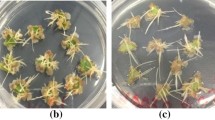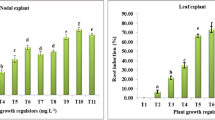Abstract
Gentiana scabra is an important medicinal herb that is used to treat inflammation, tuberculosis, rheumatism, cholecystitis, and hepatitis. The primary bioactive components in G. scabra are secoiridoids derived from the roots and rhizomes of the plant. In this study, we sought to establish a means of reliably producing these secoiridoids through G. scabra in vitro adventitious root culture. To that end, we studied the effect of phytohormones, light condition, explant type, and medium composition on adventitious root induction and secoiridoid production. Maximal induction frequency (100%) was ultimately achieved when using leaf explants cultured on Murashige and Skoog (MS) medium containing 3.0 mg L−1 NAA and 0.25 mg L−1 TDZ with a 16/8-h photoperiod, yielding 53.20 ± 3.15 roots per explant. We explored root growth curves over an 8-wk period in MS liquid medium prepared as above, and observed maximal fresh weight (FW) and dry weight (DW) values of 26.94 ± 0.38 g per flask and 1.79 ± 0.032 g per flask, respectively, in 4-wk-old cultures. The accumulation of secoiridoids (gentiopicroside, swertiamarin, and sweroside) in these adventitious root cultures was assessed via high-performance liquid chromatography (HPLC), revealing maximal gentiopicroside (25.59 ± 0.65 mg g−1 DW), swertiamarin (1.61 ± 0.04 mg g−1 DW), and sweroside (4.42 ± 0.11 mg g−1 DW) levels after 4 wk. Together, our results reveal that G. scabra adventitious root cultures represent a viable approach to the in vitro production of secoiridoids. This is the first study to our knowledge to have explored the isolation of secoiridoids following the in vitro growth of G. scabra adventitious roots. These data may represent an important step toward the development of large-scale adventitious root cultures for commercial secoiridoids production.




Similar content being viewed by others
References
Aberham A, Pieri V, Croom EM Jr, Ellmerer E, Stuppner H (2011) Analysis of iridoids, secoiridoids and xanthones in Centaurium erythraea, Frasera caroliniensis and Gentiana lutea using LC-MS and RP-HPLC. J Pharm Biomed Anal 54:517–525
Adil M, Abbasi BH, Khan T (2015) Interactive effects of melatonin and light on growth parameters and biochemical markers in adventitious roots of Withania somnifera L. Plant Cell Tiss Org Cult 123:405–412
Ahmad N, Fatima N, Ahmad I, Anis M (2015) Effect of PGRs in adventitious root culture in vitro: present scenario and future prospects. Rend Fis Acc Lincei 26:307–321
Alaguero-Cordovilla A, Sánchez-García AB, Ibáñez S, Albacete A, Cano A, Acosta M, Pérez-Pérez JM (2021) An auxin-mediated regulatory framework for wound-induced adventitious root formation in tomato shoot explants. Plant Cell Environ. https://doi.org/10.1111/pce.14001
Anjusha S, Gangaprasad A (2017) Callus culture and in vitro production of anthraquinone in Gynochthodes umbellata (L.) Razafim. & B. Bremer (Rubiaceae). Ind Crop Prod 95:608–614
Arnao MB, Hernandez-Ruiz J (2009) Protective effect of melatonin against chlorophyll degradation during the senescence of barley leaves. J Pineal Res 46:58–63
Baque MA, Hahn EJ, Paek KY (2010) Growth, secondary metabolite production and antioxidant enzyme response of Morinda citrifolia adventitious root as affected by auxin and cytokinin. Plant Biotechnol Rep 4:109–116
Baque MA, Moh SH, Lee EJ, Zhong JJ, Paek KY (2012) Production of biomass and useful compounds from adventitious roots of high-value added medicinal plants using bioreactor. Biotechnol Adv 30:1255–1267
Božić D, Skorić M, Šiler B, Živković S, Todorović S, Dmitrović S, Banjanac T, Mišić D (2015) Secoiridoid glycosides production in hairy roots of Gentiana pneumonanthe L.: optimization of cytokinin concentration in the culture medium. Bot Serb 39:79–86
Branka V, Dijana KM, Teodora J, Snezana ZK, Dragan V (2013) Quantitative determination of secoiridoid and xanthone glycosides of Gentiana dinarica Beck cultured in vitro. Acta Physiol Plant 35:567–574
Cui XH, Chakrabarty D, Lee EJ, Paek KY (2010) Production of adventitious roots and secondary metabolites by Hypericum perforatum L. in a bioreactor. Bioresour Technol 101:4708–4716
Fazal H, Abbasi BH, Ahmad N (2014) Optimization of adventitious root culture for production of biomass and secondary metabolites in Prunella vulgaris L. Appl Biochem Biotechnol 174:2086–2095
Fazal H, Abbasi BH, Ahmad N, Ali M, Ali S (2016) Sucrose induced osmotic stress and photoperiod regimes enhanced the biomass and production of antioxidant secondary metabolites in shake-flask suspension cultures of Prunella vulgaris L. Plant Cell Tiss Org Cult 124:573–581
Huang SH, Vishwakarma RK, Lee TT, Chan HS, Tsay HS (2014) Establishment of hairy root lines and analysis of iridoids and secoiridoids in the medicinal plant Gentiana scabra. Bot Stud 55:17
Jiang M, Cui BW, Wu YL, Nan JX, Lian LH (2021) Genus Gentiana: A review on phytochemistry, pharmacology and molecular mechanism. J Ethnopharmacol 264:113391
Jiang YJ, Piao XC, Liu JS, Jiang J, Lian ZX, Kim MJ, Lian ML (2015) Bioactive compound production by adventitious root culture of oplopanax elatus in balloon-type airlift bioreactor systems and bioactivity property. Plant Cell Tiss Org Cult 123:413–425
Kakuda R, Iijima T, Yaoita Y, Machida K, Kikuchi M (2002) Triterpenoids from Gentiana scabra. Phytochemistry 59:791–794
Kapoor S, Sharma A, Bhardwaj P, Sood H, Saxena S, Chaurasia OP (2019) Enhanced production of phenolic compounds in compact callus aggregate suspension cultures of Rhodiola imbricata Edgew. Appl Biochem Biotechnol 187:817–837
Khan MA, Abbasi BH, Shah NA, Yücesan B, Ali H (2015) Analysis of metabolic variations throughout growth and development of adventitious roots in Silybum marianum L. (Milk thistle), a medicinal plant. Plant Cell Tiss Org Cult 123:501–510
Khan T, Abbasi BH, Khan MA, Azeem M (2017) Production of biomass and useful compounds through elicitation in adventitious root cultures of Fagonia indica. Ind Crop Prod 108:451–457
Khanam MN, Anis M, Ahmad S (2018) Establishment of adventitious root cultures of Allamanda cathartica L. for the production of iridoid glycosides and its identification using HPTLC MS. Ind Crop Prod 125:198–206
Krstić-Milošević D, Janković T, Uzelac B, Vinterhalter D, Vinterhalter B (2017) Effect of elicitors on xanthone accumulation and biomass production in hairy root cultures of Gentiana dinarica. Plant Cell Tiss Org Cult 130:631–640
Krstić-Milošević D, Janković T, Vinterhalter B, Menković N, Aljanćić I, Vinterhalter D (2013) Influence of carbohydrate source on xanthone content in root cultures of Gentiana dinarica Beck. Plant Growth Regul 71:147–155
Lee YS, Yang TJ, Park SU, Baek JH, Wu SQ, Lim KB (2011) Induction and proliferation of adventitious roots from Aloe vera leaf tissues for in vitro production of aloe-emodin. Plant Omics 4:190–194
Lim YJ, Eom SH (2013) Effects of different light types on root formation of Ocimum basilicum L. cuttings. Sci Hortic 164:552–555
Liu SJ, Cai Q (2017) Trends of gentiopicroside, swertiamarin, and sweroside from Gentianae Radix et Rhizoma in different harvesting time. Drugs Clinic 32:19–22
Lu M, Wong H, Teng W (2001) Effects of elicitation on the production of saponin in cell culture of Panax ginseng. Plant Cell Rep 20:674–677
Martin KP, Zhang CL, Hembrom ME, Slater A, Madassery J (2008) Adventitious root induction in Ophiorrhiza prostrata: a tool for the production of camptothecin (an anticancer drug) and rapid propagation. Plant Biotechnol Rep 2:163–169
Mehrotra S, Goel MK, Srivastava V, Rahman LU (2015) Hairy root biotechnology of Rauwolfia serpentina: a potent approach for the production of pharmaceutically important terpenoid indole alkaloids. Biotechnol Lett 37:253–263
Murashige T, Skoog F (1962) A revised medium for rapid growth and bioassays with tobacco tissue culture. Physiol Plant 15:473–497
Peeters AJ, Gerards W, Barendse GW, Wullems GJ (1991) In vitro flower bud formation in tobacco: interaction of hormones. Plant Physiol 97:402–408
Piątczak E, Jeleń A, Makowczyńska J, Zielińska S, Kuźma Ł, Balcerczak E (2019) Establishment of hairy root cultures of Rehmannia elata N.E. Brown ex Prain and production of iridoid and phenylethanoid glycosides. Ind Crop Prod 137:308–314
Praveen N, Murthy HN (2010) Production of withanolide-A from adventitious root cultures of Withania somnifera. Acta Physiol Plant 32:1017–1022
Roy A, Bharadvaja N (2019) Establishment of root suspension culture of Plumbago zeylanica and enhanced production of plumbagin. Ind Crop Prod 137:419–427
Saeed S, Ali H, Khan T, Kayani W, Khan MA (2017) Impacts of methyl jasmonate and phenyl acetic acid on biomass accumulation and antioxidant potential in adventitious roots of Ajuga bracteosa Wall ex Benth., a high valued endangered medicinal plant. Physiol Mol Biol Plants 23:229–237
Saiman MZ, Mustafa NR, Schulte AE, Verpoorte R, Choi YH (2012) Induction, characterization, and NMR-based metabolic profiling of adventitious root cultures from leaf explants of Gynura procumbens. Plant Cell Tiss Org Cult 109:465–475
Sharma SN, Jha Z, Sinha RK (2013) Establishment of in vitro adventitious root cultures and analysis of andrographolide in Andrographis paniculata. Nat Prod Commun 8:1045–1047
Shen T, Zhang W, Zhao YL, Wang YZ, Jin H (2015) Content of main bioactive constituents and quality evaluation for wild grown and cultivated Gentiana rigescens Franch. ex Hemsl. Chin J Pharm Anal 35:979–985
Silja PK, Satheeshkumar K (2015) Establishment of adventitious root cultures from leaf explants of Plumbago rosea and enhanced plumbagin production through elicitation. Ind Crop Prod 76:479–486
Sivanandhan G, Arun M, Mayavan S, Rajesh M, Mariashibu TS, Manickavasagam M, Selvaraj N, Ganapathi A (2012) Chitosan enhances withanolides production in adventitious root cultures of Withania somnifera (L.) Dunal. Ind Crop Prod 37:124–129
Vinterhalter B, Krstić-Milošević D, Janković T, Pljevljakušić D, Ninković S, Smigocki A, Vinterhalter D (2015) Gentiana dinarica Beck. hairy root cultures and evaluation of factors affecting growth and xanthone production. Plant Cell Tiss Org Cult 121:667–679
Wang J, Li JX, Li JL, Gao WY (2017a) Application of plant tissue culture in field of Chinese medicine resources. Zhongguo Zhong Yao Za Zhi 42:2236–2246
Wang LL, Yin HB, Zhang ZY, Du WJ, Qi Y, Jia XQ (2017b) Correlation analysis between different soil nitrogen and Gentiana active components. J Liaoning Univ Tradit Chin Med 19:72–75
Wang YM, Xu M, Wang D, Zhu HT, Yang CR, Zhang YJ (2012) Review on "Long-Dan", one of the traditional Chinese medicinal herbs recorded in Chinese pharmacopoeia. Nat Prod Bioprospect 2:1–10
Xu Y, Li Y, Maffucci KG, Huang L, Zeng R (2017) Analytical methods of phytochemicals from the genus Gentiana. Molecules 22:2080
Yan YH, Li JL, Zhang XQ, Yang WY, Wan Y, Ma YM, Zhu YQ, Peng Y, Huang LK (2014) Effect of naphthalene acetic acid on adventitious root development and associated physiological changes in stem cutting of Hemarthria compressa. PLoS One 9:e90700
Zhang HL, Xue SH, Pu F, Tiwari RK, Wang XY (2010) Establishment of hairy root lines and analysis of gentiopicroside in the medicinal plant Gentiana macrophylla. Russ J Plant Physiol 57:110–117
Zhang Y, Wang C, Xu H, Shi X, Zhen W, Hu Z, Huang J, Zheng Y, Huang P, Zhang KX, Xiao X, Hao X, Wang X, Zhou C, Wang G, Li C, Zheng L (2019) HY5 contributes to light-regulated root sstem architecture under a root-covered culture system. Front Plant Sci 10:1490
Zhu HY, Guan J, Guo XC, Feng B (2011) RP-HPLC simultaneous determination of three active components in Radix Gentianae. Chin J Pharm Anal 31:2298–2301
Funding
This study was supported by the key project at central government level: The ability establishment of sustainable use for valuable Chinese medicine resources (NO.2060302).
Author information
Authors and Affiliations
Corresponding author
Ethics declarations
Ethics approval
The authors declare that the study was carried out following scientific ethics and conduct.
Conflict of interest
The authors declare that they have no competing interests.
Additional information
Editor: Jorge Canhoto
Rights and permissions
About this article
Cite this article
Hao, N., Piao, Z., Zang, J. et al. Establishment of adventitious root cultures and assessment of secoiridoid production in the Chinese medicinal plant Gentiana scabra. In Vitro Cell.Dev.Biol.-Plant 57, 864–873 (2021). https://doi.org/10.1007/s11627-021-10186-0
Received:
Accepted:
Published:
Issue Date:
DOI: https://doi.org/10.1007/s11627-021-10186-0




